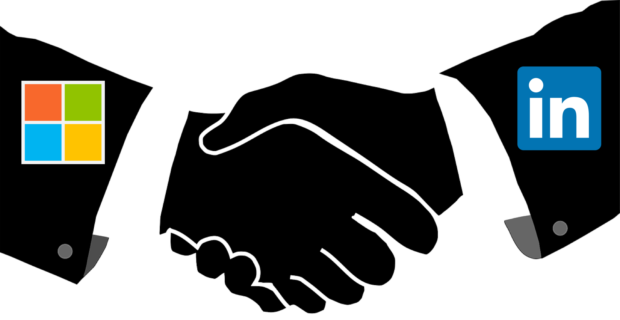Microsoft Acquiring LinkedIn is Good for Data, But Questionable Strategic Fit
by Lindsay Rowntree on 16th Jun 2016 in News

On Monday, 13 June, Microsoft Corp (NASDAQ: MSFT) announced the acquisition of LinkedIn Corporation (NYSE: LNKD) for a cash deal valued at USD$26.2bn (£18.44bn). With the help of industry leaders, ExchangeWire evaluate this huge deal.
Microsoft’s announcement that it is acquiring LinkedIn came as a complete surprise for many, for a number of reasons. Firstly, LinkedIn is not actually a profitable company. In its full-year 2015 earnings results, LinkedIn’s GAAP net loss attributable to common stakeholders was USD$166m (£117m). Adjusted profit looks more favourable, at USD$71m (£50m), but would certainly make analysts question why LinkedIn achieved such a huge sale price.
Secondly, Microsoft’s acquisitive nature certainly hasn’t reaped rewards in the past: the USD$7.6bn (£5.3bn) purchase of Nokia’s mobile phone assets in 2014, which had to be written off just one year later; the USD$1.2bn (£845m) purchase of Yammer in 2012, which hasn’t come good on its aim of being a leading enterprise social platform, and is only now receiving a revamp, four years after purchase; Skype’s USD$8.5bn (£6bn) acquisition in 2011, which, in an ongoing theme, was essentially left for five years before Microsoft announced a strategy overhaul; and aQuantive’s USD$6.3bn (£4.4bn) purchase in 2007, where Microsoft had to write off almost the entire acquisition five years down the line. Microsoft certainly has a chequered acquisition history.
Thirdly, it is difficult to fathom why Microsoft would have any interest in LinkedIn, as the two seem to operate in different worlds that don’t necessarily align.
According to the official release, Microsoft “seek to empower every person and organisation on the planet” and they believe that their cloud and LinkedIn’s network will give them that opportunity. Although it would be conceivable that many of LinkedIn’s 433 million members probably already use Microsoft’s suite of products in some guise or another; so, it would be more a case of first-party data enrichment than tapping into a whole new audience. Data and a golden opportunity for Microsoft to develop their enterprise social offering – something which has eluded them in the past.
From a consumer perspective, there could be some potential benefits in the form of (slightly) less fragmentation between social profiles. The ability to marry up LinkedIn profile information with Outlook, Skype, or Yammer profiles would be advantageous, but only for Microsoft’s business customers – a consumer using a personal email account to buy a used set of golf clubs from Gumtree may not be that bothered about the seller’s employment history. However, that could have been integrated without a USD$26.2bn (£18.44bn) price tag. Similar options already exist within Gmail browser extensions, allowing you to connect to email senders’ LinkedIn profiles directly within the Gmail client.
All eyes will be on Microsoft and LinkedIn over the coming months and years to see how Microsoft’s backing helps to develop LinkedIn’s offering and the efficacy of the enterprise social network being integrated into Microsoft’s product suite.
ExchangeWire sought the opinions of industry leaders on the motive behind Microsoft’s latest acquisition.
This poses a real threat to Salesforce
"Microsoft’s core business is built around enterprise productivity software. They’ve been increasingly under threat from all sorts of players competing for pole position in this space.
"Google and Facebook, two of the biggest tech companies in the world, with strong consumer propositions, have moved heavily into this enterprise area, with Facebook at Work and Google for Work. Doing nothing was not an option for Microsoft, hence this massive, bold coup. LinkedIn is one of the best new business/sales tools in the world of B2B and, in many ways, competes head-on with Salesforce. When Microsoft integrates LinkedIn with its CRM suite, Dynamics, what you have is a hugely powerful tool that is truly differentiated and one that poses a real threat to Salesforce. So, in short, a brilliant, bold move from Microsoft, and if anyone is going to be feeling unnerved by the deal, it’s Salesforce. We should expect to see some sort of announcement from them in the months ahead."
Julie Langley, Partner, Results International
Not a clear strategic fit
"The first thing is, this deal is not about advertising – which is not a core business for either company. Microsoft is betting on LinkedIn as a strategic asset that can help accelerate sales and adoption of their core software businesses – in this case, that's probably Office365. It’s not immediately clear to me how that strategic fit manifests – honestly, this deal is a bit of head-scratcher at present. But, clearly, Microsoft sees the synergy and was willing to pay a huge premium for the opportunity to execute on it."
Matthew Greitzer, Co-founder & COO of Accordant Media
It’s all about data
"Many say data is the oil of the 21st century; and the acquisition of LinkedIn by Microsoft goes some way to support this. LinkedIn may not boast more users than Twitter, but it is the depth of data for each of these professional members that makes it so valuable in today’s digital advertising ecosystem. With so much rich first-party data now available at Microsoft’s fingertips, it provides them with the ability to gather unrivalled insights into the professional community. Microsoft can now link the data from usage of its Office product suite with the social and content consumption data from the same user’s LinkedIn profile – these combined, if used correctly, create huge potential for ad targeting and monetisation opportunities. The personalisation that will be afforded to those with access to this data set will be great. I think we really will see Microsoft and LinkedIn connect the professional world."
Giovanni Strocchi, CEO at ADmantX








Follow ExchangeWire